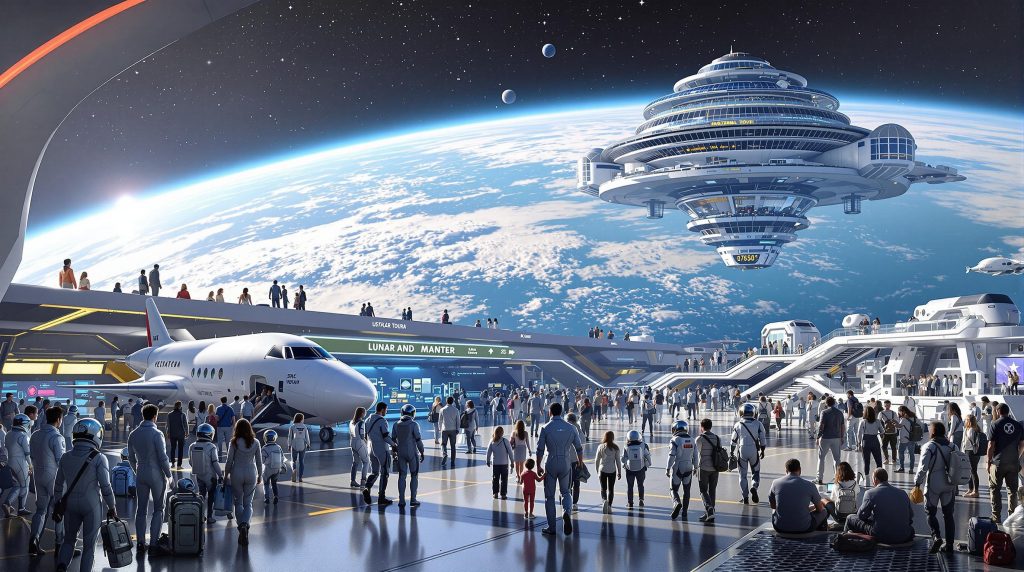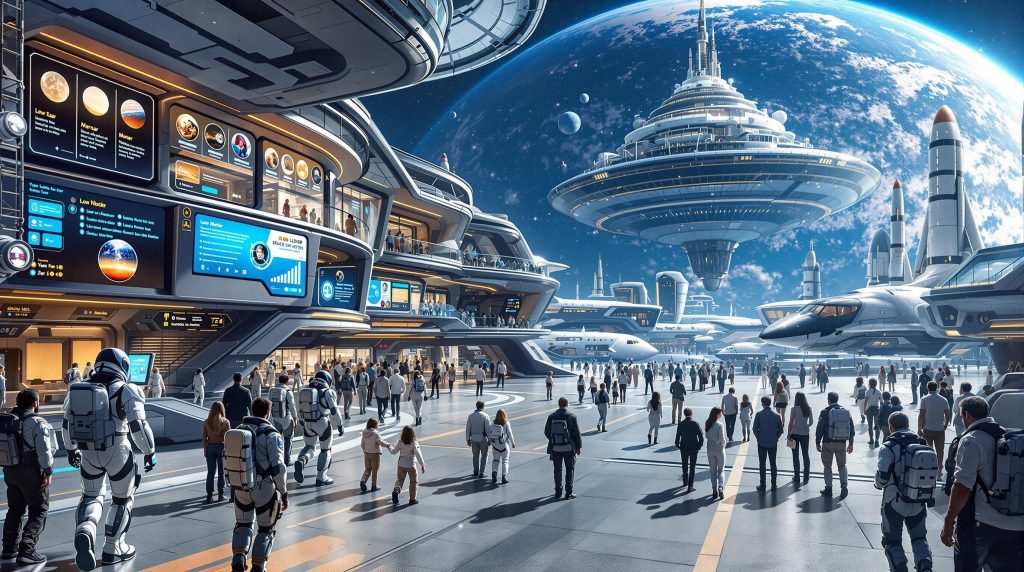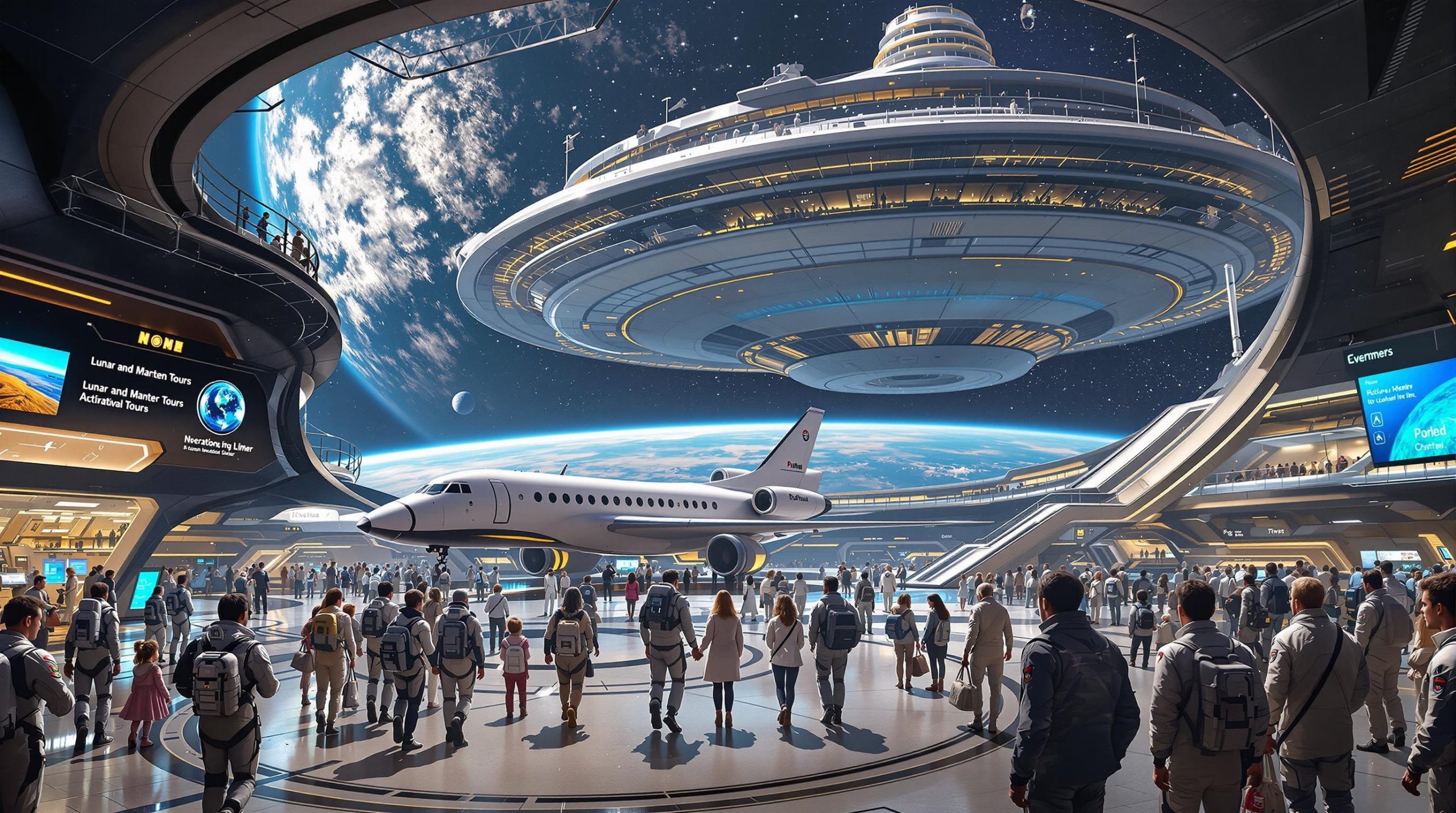Space tourism, once a concept relegated to the realm of science fiction, is rapidly evolving into a tangible industry. With advancements in technology, decreasing costs of space travel, and the growing interest of private companies and governments, the next decade promises to be transformative for this nascent sector. This article delves into the potential developments, challenges, and opportunities shaping the future of space tourism. Stay with Spaceyv
The Current State of Space Tourism
As of 2025, space tourism is still in its infancy. Companies like SpaceX, Blue Origin, and Virgin Galactic have made significant strides in making space travel accessible to civilians. Landmark events, such as SpaceX’s Inspiration4 mission and Blue Origin’s suborbital flights, have already demonstrated the feasibility of commercial space travel. However, these experiences remain exclusive due to their high costs, limiting participation to wealthy individuals and corporate sponsors.

Virgin Galactic offers suborbital flights, providing passengers with a few minutes of weightlessness and breathtaking views of Earth from space. Blue Origin’s New Shepard has similarly conducted several successful suborbital missions. Meanwhile, SpaceX has taken a bold step with orbital missions, including plans for private lunar flybys. These efforts have set the stage for the broader democratization of space travel in the coming decade.
Technological Advancements Driving Space Tourism
1. Reusable Rockets
One of the most significant advancements fueling the growth of space tourism is the development of reusable rockets. Companies like SpaceX have demonstrated the ability to launch, land, and reuse rockets multiple times, drastically reducing the cost of each mission. In the next decade, further refinements in reusable technology are expected to make space travel more affordable and accessible to a broader audience.
2. Space Habitats
Orbital habitats, such as those proposed by Axiom Space and Orbital Assembly Corporation, could become reality within the next ten years. These habitats are designed to accommodate tourists, researchers, and astronauts, offering luxurious and functional living spaces in low Earth orbit. Space hotels could provide extended stays for tourists, including activities like spacewalking and stargazing.
3. Safer Spacecraft
Safety remains a paramount concern for space tourism. Advances in materials science, artificial intelligence, and autonomous navigation systems are expected to make spacecraft more reliable and secure. Enhanced escape systems and real-time monitoring technologies will play critical roles in ensuring passenger safety.
4. Advanced Propulsion Systems
The development of advanced propulsion systems, such as ion thrusters and nuclear propulsion, may enable faster and more efficient travel to destinations beyond low Earth orbit. These technologies could open up possibilities for lunar and even Martian tourism within the next decade.
What to Expect in the Next Decade
1. Increased Accessibility
As competition among space tourism companies intensifies, prices are likely to decrease, making space travel accessible to a wider demographic. Partnerships with governments and private entities could lead to subsidized flights, educational programs, and contests that offer opportunities for ordinary people to experience space.

2. Expansion of Destinations
While current space tourism missions are limited to suborbital and orbital experiences, the next decade may see an expansion to more exotic destinations. The Moon is a prime candidate, with companies like SpaceX planning lunar flybys and even lunar landings for tourists. Mars remains a longer-term goal but could become feasible toward the end of the decade with advancements in life support systems and spacecraft durability.
3. Customized Experiences
Tourism companies are likely to offer personalized experiences to cater to different interests. Options could include:
- Educational Tours: Learning about astronomy, space science, and the history of space exploration while in orbit.
- Adventure Packages: Including activities like spacewalking and piloting spacecraft simulators.
- Luxury Stays: Featuring gourmet meals, private quarters, and spa-like amenities in space habitats.
4. Integration with the Entertainment Industry
Space tourism may merge with entertainment, leading to movies, concerts, and other events being produced in space. This could further popularize space travel and create new revenue streams for companies involved.
Challenges to Overcome
1. High Costs
Despite technological advancements, the cost of space travel remains prohibitively high for most people. Continued innovation and economies of scale will be crucial in reducing prices.
2. Environmental Concerns
The environmental impact of rocket launches, particularly their carbon emissions, poses a significant challenge. Developing eco-friendly propulsion systems and minimizing the ecological footprint of space tourism will be critical for its sustainability.
3. Regulatory Hurdles
The regulatory framework for space tourism is still evolving. Governments and international organizations must establish clear guidelines to ensure safety, liability, and ethical considerations are addressed.
4. Health Risks
Space travel exposes passengers to unique health risks, including radiation, microgravity effects, and the psychological challenges of isolation. Comprehensive training and medical support will be necessary to mitigate these risks.
The Broader Implications of Space Tourism
Space tourism has the potential to transform human perspectives and economies. It could inspire a new generation of scientists, engineers, and explorers, fostering a greater appreciation for our planet and the cosmos. Additionally, the industry could drive technological advancements with applications beyond space travel, such as in transportation, energy, and materials science.
Moreover, space tourism could serve as a stepping stone for humanity’s expansion into the solar system. By building the infrastructure and expertise needed for commercial space travel, we pave the way for colonization, resource extraction, and interplanetary exploration.
Conclusion
The future of space tourism is bright, filled with opportunities for adventure, innovation, and discovery. Over the next decade, advances in technology, increased competition, and a growing interest in space exploration are likely to make space travel more accessible and diverse. However, challenges related to cost, safety, and sustainability must be addressed to ensure the industry’s long-term success.
As we stand on the brink of this new frontier, space tourism promises not only to fulfill humanity’s age-old dream of exploring the cosmos but also to redefine our place within it. The next decade will undoubtedly be a pivotal chapter in the story of human spaceflight, one that brings the stars closer than ever before.
Sources
National Aeronautics and Space Administration (NASA)
Website: https://www.nasa.gov
SpaceX Official Website
Website: https://www.spacex.com
Virgin Galactic Official Website
Website: https://www.virgingalactic.com
Blue Origin Official Website
Website: https://www.blueorigin.com



